Evaluating the Capability of Grass Swale for the Rainfall Runoff Reduction from an Urban Parking Lot, Seoul, Korea
Abstract
:1. Introduction
2. Study Objectives
- ■
- To measure the soil water contents which significantly influence the rainfall runoff reduction.
- ■
- Investigate the performance of grass swale to detain rainfall runoff in different precipitation events. Evaluate the feasibility of grass swale as a Low Impact Development (LID) measure to reduce the risk of urban flooding in Korea.
3. Materials and Methods
3.1. Study Area Descriptions and Details
3.2. Data Processing and Analysis
4. Results
4.1. Grass Swale Soil Moisture Response
Soil Moisture Seasonal Effect
4.2. Grass Swale Water Level Measurement
4.3. Rainfall Runoff Attenuation
5. Discussion
6. Conclusions
- ○
- Grass swales are very effective during small rain events because all the rainwater infiltrates into the swale soil and thereby was zero rainfall runoff outflow during these small events. The grass swale construction tries to mimic the natural hydrological conditions by changing concrete pavement parking into natural vegetation. Grass swale vegetation not only captures rainfall runoff but also evaporates water into the atmosphere. During big storm events, the results indicated that the grass swale soil captured more rainwater and hence enhanced the moisture content from 35% to 57%. It was also found that the selection of soil media is very important for grass swale construction [24,25]. As the grass swale has three specific functions: retention, infiltration and conveyance. However the first two segments—retention and infiltration—are very important factors that can hold and infiltrate all rainfall runoff and produce zero runoff. During this study, the grass swale retained rainfall runoff from around 0.3 to 0.4 m rainfall during different storm events. From the field experiments, it was proved that grass swale may retain a total rainfall runoff of about 40–75% of small storm events.
- ○
- It is also proved that during small storm events the hydrographic peak is much smaller as compared to big storm events. This is due to the fact that in the case of small storm events almost all the rainwater is infiltrated and captured in the grass swale. However, in case of big storm events as the soil depth of grass already fully saturated and does not have the ability to capture more runoff, therefore the runoff flows into the underground trench. However, future studies need to be carried out by increasing the soil characteristics for more runoff retention performance of the grass swale and thereby checking their performance for stormwater management in urban areas. All the results provided in this study proved that the grass swale is a very effective best management practice to control rainfall runoff in highly urbanized areas like Seoul, Korea.
Acknowledgments
Author Contributions
Conflicts of Interest
References
- United States Environmental Protection Agency (USEPA). National Water Quality Inventory: Report to Congress; EPA 841-R-08-001; U.S. Environmental Protection Agency, Office of Water: Washington, DC, USA, 2004.
- Todeschini, S. Hydrologic and Environmental Impacts of Imperviousness in an Industrial Catchment of Northern Italy. J. Hydrol. Eng. 2016, 21, 05016013. [Google Scholar] [CrossRef]
- Booth, D.; Hartley, D.; Jackson, R. Forest cover, impervious surface area, and the mitigation of storm-water impacts. J. Am. Water Resour. Assoc. 2002, 38, 835–845. [Google Scholar] [CrossRef]
- Kim, R. Low Impact Development and Green Infrastructure in South Korea: Trends and Future Directions. Ecol. Resil. Infrastruct. 2016, 3, 80–91. [Google Scholar] [CrossRef]
- Shafique, M.; Kim, R. Retrofitting the Low Impact Development Practices into Developed Urban areas Including Barriers and Potential Solution. Open Geosci. 2017, 9, 240–254. [Google Scholar] [CrossRef]
- Shafiquea, M.; Kima, R. Green stormwater infrastructure with low impact development concept: A review of current research. Des. Water Treat. 2017, 83, 16–29. [Google Scholar] [CrossRef]
- Line, D.; White, N. Effects of development on runoff and pollutant export. Water Environ. Res. 2007, 79, 185–190. [Google Scholar] [CrossRef] [PubMed]
- Pyke, C.; Warren, M.P.; Johnson, T.; LaGro, J.; Scharfenberg, J.; Groth, P.; Freed, R.; Schroeer, W.; Main, E. Assessment of low impact development for managing stormwater with changing precipitation due to climate change. Lands. Urban Plan. 2011, 103, 166–173. [Google Scholar] [CrossRef]
- Hood, M.J.; Clausen, J.C.; Warner, G.S. Comparison of stormwater lag times for low impact and traditional residential development. JAWRA J. Am. Water Res. Assoc. 2007, 43, 1036–1046. [Google Scholar] [CrossRef]
- Vogel, R.J.; Moore, T.L.; Coffman, R.R.; Rodie, S.N.; Hutchinson, S.L.; McDonough, K.R.; McLemore, A.J.; McMaine, J.T. Critical review of technical questions facing low impact development and green Infrastructure: A perspective from the great plains. Water Environ. Res. 2015, 87, 849–862. [Google Scholar] [CrossRef] [PubMed]
- Grebel, J.E.; Mohanty, S.K.; Torkelson, A.A.; Boehm, A.B.; Higgins, C.P.; Maxwell, R.M.; Nelson, K.L.; Sedlak, D.L. Engineered infiltration systems for urban stormwater reclamation. Environ. Eng. Sci. 2013, 30, 437–454. [Google Scholar] [CrossRef]
- Revitt, D.M.; Ellis, J.B.; Lundy, L. Assessing the impact of swales on receiving water quality. Urban Water J. 2017, 14. [Google Scholar] [CrossRef]
- Ahiablame, L.M.; Engel, B.A.; Chaubey, I. Effectiveness of low impact development practices: Literature review and suggestions for future research. Water Air Soil Pollut. 2012, 223, 4253–4273. [Google Scholar] [CrossRef]
- Li, H.; Li, K.; Zhang, X. Performance Evaluation of Grassed Swales for Stormwater Pollution Control. Procedia Eng. 2016, 154, 898–910. [Google Scholar] [CrossRef]
- Shen, Z.X.; Kan, L.Y.; Che, S.W. Effects of grass swales structure parameters on storage and pollutant removal of rainfall runoff. J. Shanghai Jiaotong Univ. (Agric. Sci.) 2015, 33, 46–52. [Google Scholar]
- Lucke, T.; Mohamed, A.; Neil, T. Pollutant removal and hydraulic reduction performance of field grassed swales during runoff simulation experiments. Water 2014, 6, 1887–1904. [Google Scholar] [CrossRef]
- Xie, J.; Wu, C.; Li, H.; Chen, G. Study on Storm-Water Management of Grassed Swales and Permeable Pavement Based on SWMM. Water 2017, 9, 840–856. [Google Scholar]
- Deletic, A.; Fletcher, T.D. Performance of grass filters used for stormwater treatment—A field and modelling study. J. Hydrol. 2006, 317, 261–275. [Google Scholar] [CrossRef]
- Ackerman, D.; Stein, E. Evaluating the effectiveness of best management practices using dynamic modeling. J. Environ. Eng. 2007, 134, 628–639. [Google Scholar] [CrossRef]
- Barrett, M.E. Comparison of BMP performance using the international BMP database. J. Irrig. Drain. Eng. 2008, 134, 556–561. [Google Scholar] [CrossRef]
- Fassman, E.A.; Liao, M. Monitoring of a Series of Swales within a Stormwater Treatment Train. In Proceedings of the 32nd Hydrology and Water Resources Symposium, Newcastle, Australia, 30 November–3 December 2009; Engineers Australia: Barton, Australia, 2009; pp. 368–378. [Google Scholar]
- Rushton, B.T. Low-impact parking lot design reduces runoff and pollutant loads. J. Water Resour. Plan. Manage. ASCE 2001, 127, 172–179. [Google Scholar] [CrossRef]
- Deletic, A. Modelling of water and sediment transport over grassed areas. J. Hydrol. 2001, 248, 168–182. [Google Scholar] [CrossRef]
- Rujner, H.; Leonhardt, G.; Perttu, A.M.; Marsalek, J.; Viklander, M. Advancing green infrastructure design: Field evaluation of grassed urban drainage swales. In Proceedings of the 9th International Conference on Planning and Technologies for Sustainable Management of Water in the City, Lyon, France, 28 June–1 July 2016. [Google Scholar]
- Davis, A.P.; Stagge, J.H.; Jamil, E.; Kim, H. Hydraulic performance of grass swales for managing highway runoff. Water Res. 2012, 46, 6775–6786. [Google Scholar] [CrossRef] [PubMed]
- Maryland Department of the Environment (MDE). Maryland Stormwater Design Manual, Vols. I and II; Maryland Department of the Environment, Water Management Administration: Baltimore, MD, USA, 2000.
- Marla, C.; KIM, L. Evaluation of the capability of low-impact development practices for the removal of heavy metal from urban stormwater runoff. Environ. Technol. 2016, 37, 2265–2272. [Google Scholar]
- BÄCKSTRÖM, M. Sediment transport in grassed swales during simulated runoff events. Water Sci. Technol. 2002, 45, 41–49. [Google Scholar] [PubMed]
- Cederkvist, K.; Jensen, M.B.; Ingvertsen, S.T.; Holm, P.E. Controlling stormwater quality with filter soil—Event and dry weather testing. Water 2016, 8, 349. [Google Scholar] [CrossRef]
- Lloyd, S. Water Sensitive Urban Design in the Australian Context. 2001. Available online: https://ewater.org.au/archive/crcch/archive/pubs/pdfs/technical200107.pdf (accessed on 10 January 2018).
- Kim, R. Policies of water cycle management in Korea and necessity of development of Korean low impact development technologies. Water Future 2014, 47, 16–21. [Google Scholar]
- Ergman, B. Sustainable Water Practices at Pomona’s Parks: Improving Irrigation Use and Stormwater Runoff Retention. 2013. Available online: http://www.cpp.edu/~tgyoung/Pom_Parks/Sustainable_Water_Practices.pdf (accessed on 10 December 2017).
- Credit Value Conservation (CVC). Advancing Low Impact Development as a Smart Solution for Stormwater Management. 2015. Available online: http://www.creditvalleyca.ca/wpcontent/uploads/2015/07/Advancing-Low-Impact621 Development-as-a-Smart-Solution-for-Stormwater-Management-v1.pdf 622 (accessed on 1 October 2017).
- Chau, H.F. Green Infrastructure for Los Angeles: Addressing Urban Runoff and Water Supply through Low Impact Development. 2009. Available online: http://www.environmentla.org/pdf/LID-Paper_4-1-09_530pm.pdf (accessed on 11 November 2017).
- Foster, J.; Lowe, A.; Winkleman, S. The Value of Green Infrastructure for Urban Climate Adaptation; Center for Clean Air Policy: Washington, DC, USA, 2011. Available online: http://ccap.org/assets/The-Value-of-Green-Infrastructure-for-Urban-Climate-Adaptation_CCAP-Feb-2011.pdf (accessed on 1 December 2017).
- US Environmental Protection Agency (US. EPA). Green Infrastructure Collaborative Statement of Purpose. 2014. Available online: https://www.epa.gov/sites/production/files/2015-10/documents/greeninfrastructure_collaborative2014_0.pdf (accessed on 12 November 2017).
- Yun, Y.; Park, H.; Kim, L.; Ko, S. Size distributions and settling velocities of suspended particles from road and highway. KSCE J. Civ. Eng. 2010, 14, 481–488. [Google Scholar] [CrossRef]
- Korea Metrological Administration (KMA). 2007. Available online: http://web.kma.go.kr/eng/weather/climate/worldclimate.jsp (accessed on 1 December 2017).
- Cunnane, C. Unbiased plotting positions e a review. J. Hydrol. 1978, 37, 205–222. [Google Scholar] [CrossRef]
- Braswell, A.S.; Anderson, A.R.; Hunt, W.F. Hydrologic and Water Quality 338 Evaluation of a Permeable Pavement and Biofiltration Device in Series. Water 2018, 10, 33. [Google Scholar] [CrossRef]
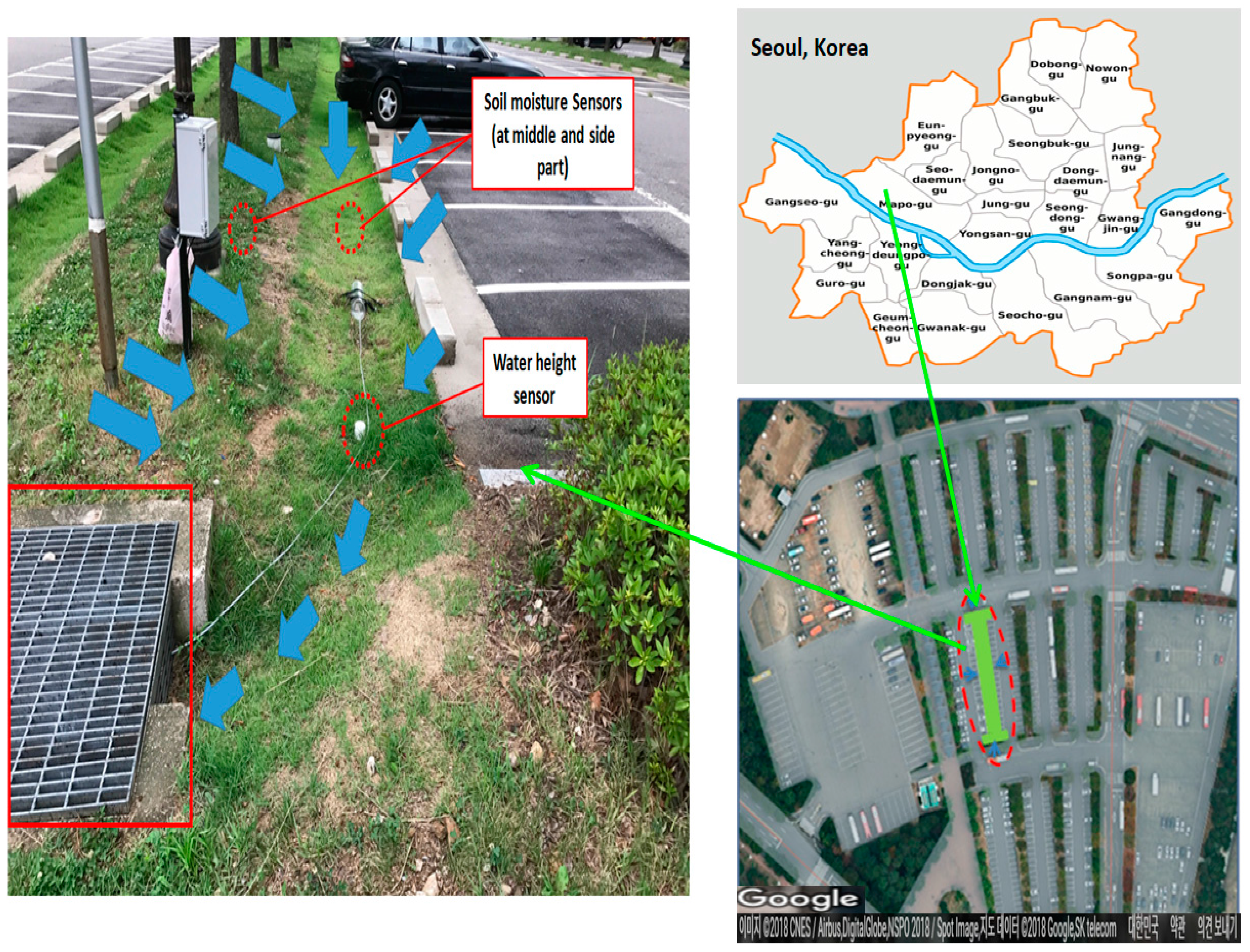
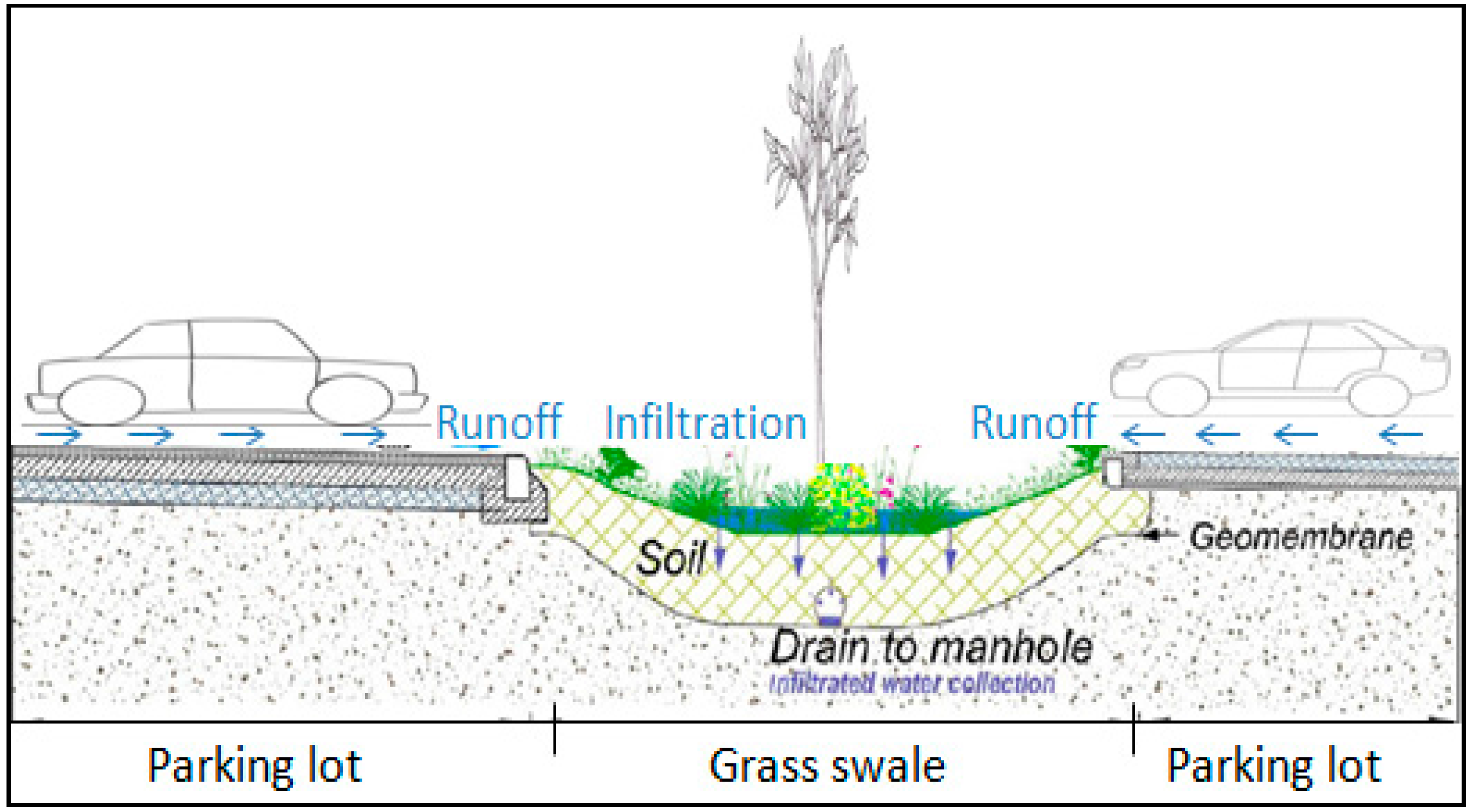
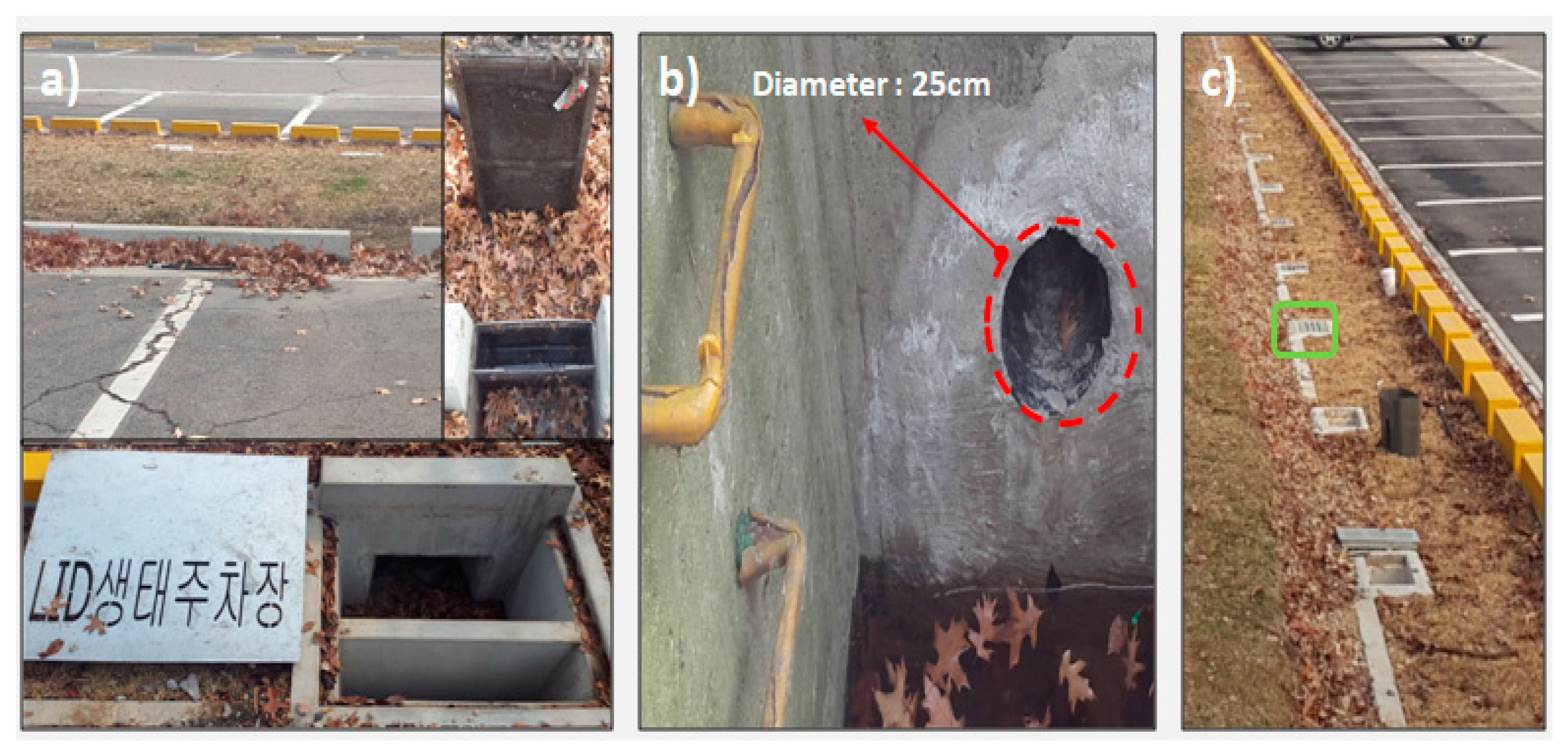

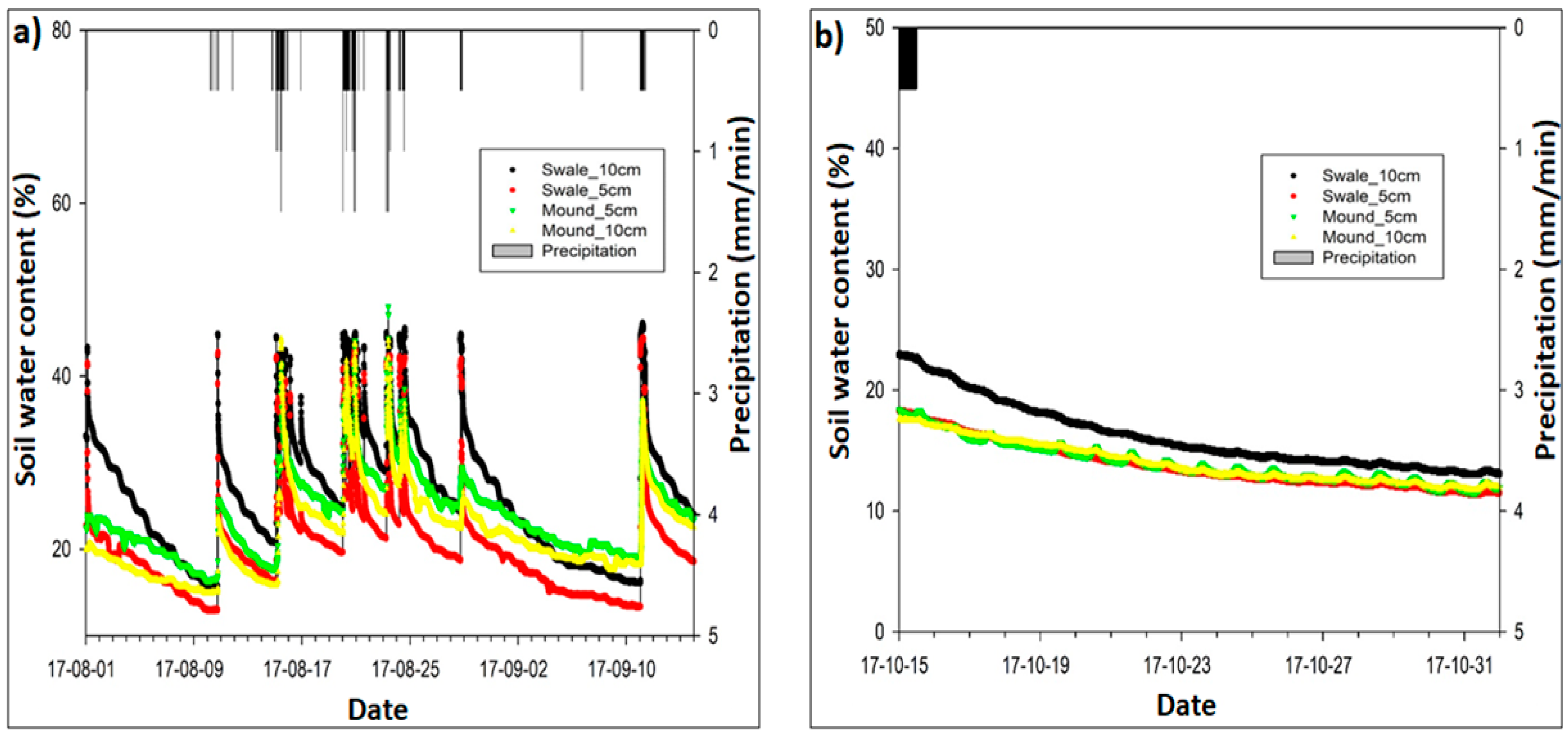


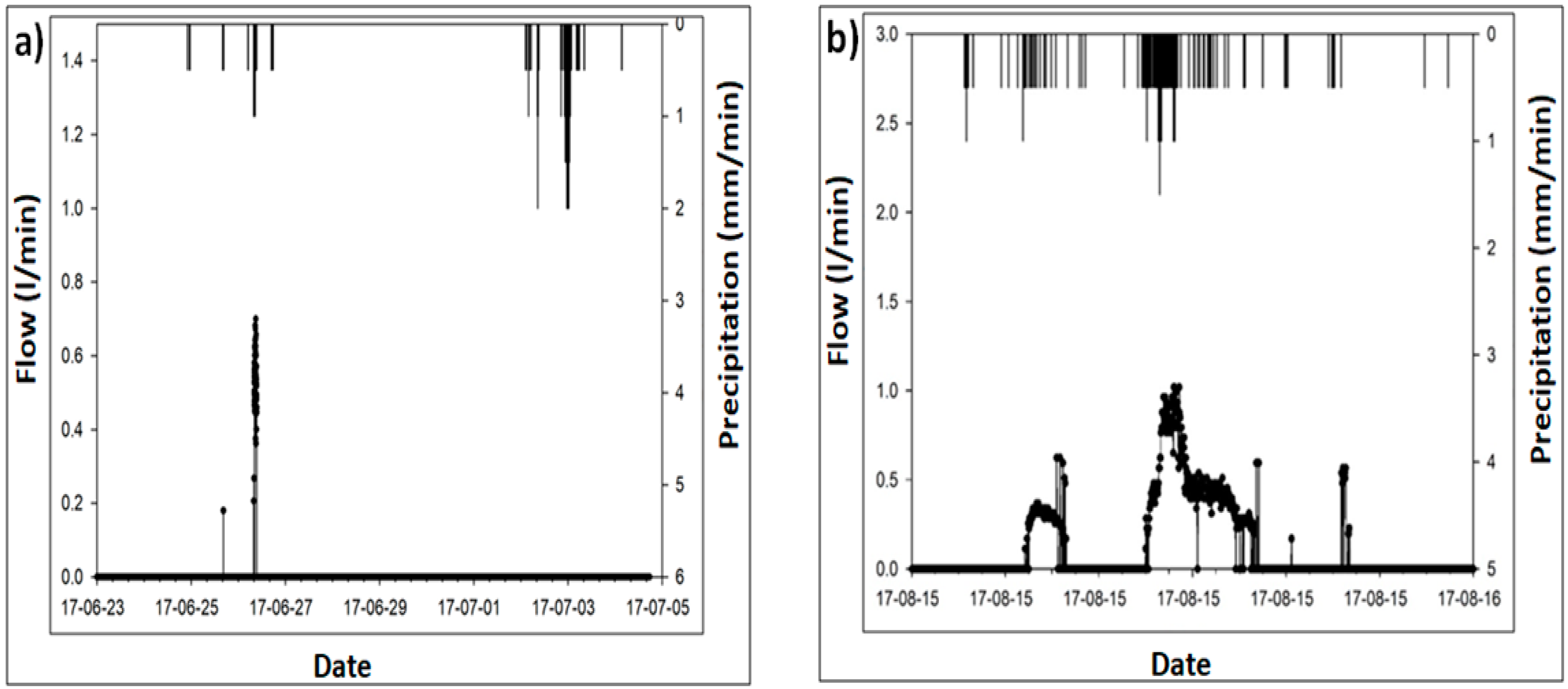
| Reference | Runoff Volume Reduction (%) | Location |
|---|---|---|
| Deletic and Fletcher (2006) [18] | 33–87% | Brisbane, Australia |
| Ackerman and Stein (2007) [19] | 52.5% | Los Angeles, USA |
| Barrett (2008) [20] | 50% | USA |
| Fassman and Liao (2009) [21] | 63.7% | New Zealand |
| Rushton (2001) [22] | 30% | Florida, USA |
| Deletic (2001) [23] | 45.7% | University of Aberdeen, UK |
| Rujner et al.(2016) [24] | 40–55% | Luleå, Sweden |
| Davis. et al. (2012) [25] | 59% | Maryland, USA |
| Parameter | Characteristics of Grass Swale |
|---|---|
| Runoff source a | Parking lot for around 30 cars |
| Design details | 0.35 m deep filter soil layer on the top of gravel layer and 0.6 m infiltration trench |
| Filter soil composition | Local soil mixed with 1:1 with sand in grain size 0.02–2 mm |
| Grass swale side slope | <2.5% |
| Surrounded impervious areas (runoff entering from all this area to grass swale) | Around 300 m2 |
| Catchment and infiltration area ratio | 4:1 |
| Grass swale length | 51 m |
| Grass swale width | 1.2 m |
| Soil compositions | Made up of using local soil composition (sand + silt + clay) |
| Monitoring period | May 2017–October 2017 |
© 2018 by the authors. Licensee MDPI, Basel, Switzerland. This article is an open access article distributed under the terms and conditions of the Creative Commons Attribution (CC BY) license (http://creativecommons.org/licenses/by/4.0/).
Share and Cite
Shafique, M.; Kim, R.; Kyung-Ho, K. Evaluating the Capability of Grass Swale for the Rainfall Runoff Reduction from an Urban Parking Lot, Seoul, Korea. Int. J. Environ. Res. Public Health 2018, 15, 537. https://doi.org/10.3390/ijerph15030537
Shafique M, Kim R, Kyung-Ho K. Evaluating the Capability of Grass Swale for the Rainfall Runoff Reduction from an Urban Parking Lot, Seoul, Korea. International Journal of Environmental Research and Public Health. 2018; 15(3):537. https://doi.org/10.3390/ijerph15030537
Chicago/Turabian StyleShafique, Muhammad, Reeho Kim, and Kwon Kyung-Ho. 2018. "Evaluating the Capability of Grass Swale for the Rainfall Runoff Reduction from an Urban Parking Lot, Seoul, Korea" International Journal of Environmental Research and Public Health 15, no. 3: 537. https://doi.org/10.3390/ijerph15030537





